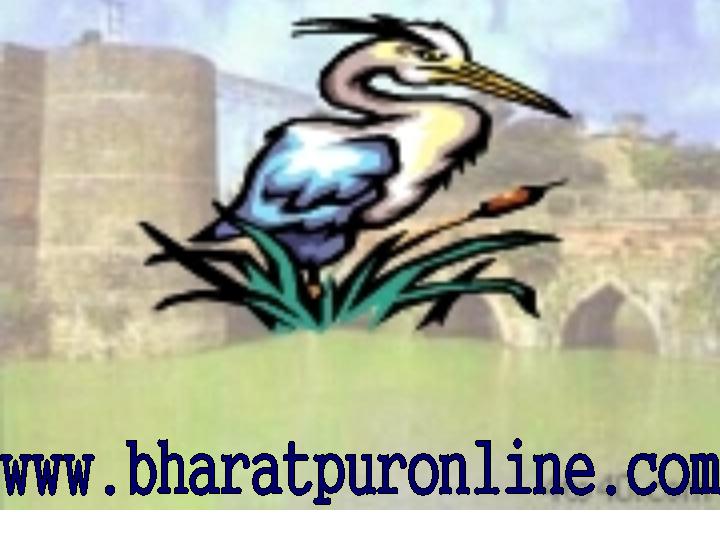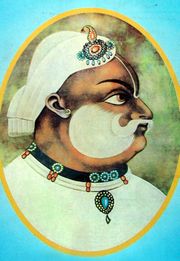| |
GOVERNMENT MUSEUM
The building Kamra Khas within the fort has been converted into a museum, displaying a rich collection of antiquaries,
exquisite sculptures and some ancient inscriptions.
 The government Museum is housed in the former durbar hall, the maharaja's meeting hall, in the fort. The most interesting
thing to see here is the hamam(bathhouse), which retains some fine carvings and frescoes.
The government Museum is housed in the former durbar hall, the maharaja's meeting hall, in the fort. The most interesting
thing to see here is the hamam(bathhouse), which retains some fine carvings and frescoes.
A rich collection of artefacts. exquisitely carved sculptures and ancient inscriptions can be admired in the Government
Museum located in the Palace. All these items speak volumes about the rich heritage, art and crafts of the region.
It exhibits sculptures found during the excavation of old villages e.g. Noh, Mallah, Bareh, Bayana etc. ranging from the Kushan
period (Ist century A.D.) to 19th century A.D. Weapons used in battles in the medieval period the Jat rulers, paintings,
manuscripts, zoological specimens, local art and craft that was once Bharatpur.
The sculptures speak volumes about the art of a by gone era and culture
typical of this area. The inscriptions are of immense historical vault and helps in tracing back the royal lineage as well as
the local life.
The Art Gallery of the museum has specimens of miniature paintings on leaves of the Peepal tree, mica and old litho papers
along with the paintings of the Maharajas of Bharatpur.
On the upper story one section consists of various types of guns & miniature canons used during 18th century A.D. Called
‘Chandra’. These miniature canons - two sets of eleven each, were used by Maharaja Sawai Jawahar Singh in the battle while
passing through the Jaipur territory on his return from a pilgrimage to Pushkar.
Only the exterior of the buildings may be photographed.
Tourist Information
Time 10:00 A.M.- 4:30 P.M.(Saturday - Thursday)
Entry Fee : RS. 3/-
(Closed on Friday)
Jawahar Burj and Fateh Burj
A few of the eight imposing towers still stand erect within the glorious ramparts of the fort. Especially two of them -
Jawahar Burj and Fateh Burj are of special interest These were built by Maharaja Suraj Malto commemorate his victories over
the Mughals and British respectively. The coronation ceremony of the Jat rulers of Bharatpur was also held at the Jawahar Burj.
The Palace

Within the precincts of the fort are three palaces — one of which, Kothi Khas, now serves as a museum while the other two,
Kishori Mahal and Mahal Khas, are sadly in a dilapidated state.
They are the fine blend of Mughal and Rajput architecture, built in various phases by different Maharajas.
These magnificent
apartments are richly decorated with patterned floor tiles with exquisite intricate designs. The museum occupies the main
central wing depicting collections dating back to 2nd century, which reflect the art and skill of the region.
Ganga Mandir ( Temple of Deity Ganga)
A very sacred temple of Deity "Ganga Maiya".
 The temple dedicated to Goddess Ganga was initiated by Maharaja Balwant Singh in 1845. However, its completion was done
in 1937 by Maharaja Brijendra Sawai. The temple is a two storeyd structure built of sandstone. The chequered floors are
painted in black and white. The terrace is best avoided as the edges are not stable and can be highly precarious
Temple is one of the ldest one in the city and local people have great respect and
proud on the temple. Located at the very heart of the city,the architecture of the temple is impressive and artistic.
The temple dedicated to Goddess Ganga was initiated by Maharaja Balwant Singh in 1845. However, its completion was done
in 1937 by Maharaja Brijendra Sawai. The temple is a two storeyd structure built of sandstone. The chequered floors are
painted in black and white. The terrace is best avoided as the edges are not stable and can be highly precarious
Temple is one of the ldest one in the city and local people have great respect and
proud on the temple. Located at the very heart of the city,the architecture of the temple is impressive and artistic.
Laxman Mandir
The Laxman Temple and the mosque are the other places of interest in the city.
KeolaDeo Bird Sanctuarty

A visit to Bharatpur would undoubtedly be incomplete without a visit to the world famous Keoladeo National Park, also known as
Ghana Bird Sanctuary.
Known as Keoldeo because of the Keoladeo temple of Lord Shiva in the vicinity, this 29 sq km area was converted into a sanctuary
by Prince Bhamji of Morvi state who had been appointed as Regent of Bharatpur towards the end of nineteenth century. Originally
intended for duck shooting by Maharaja Kishan Singh, an area of 11 sq km was got filled with water from the Ajan Bundh reservoir
and then drained out, leaving the low land filled with water. Bushes of babool and other thorny trees were got planted to
attract varieties of birds. The first shoot was organized by the rulers of Bharatpur in 1902 in honor of Lord Curzon. Lord
Linlithgow, Viceroy and Governor-General of India, established a record of shooting 4273 ducks in 1938. Among the royal guests
of the Bharatpur ruler were visitors from Afghanistan, Iran, Malaysia and few other countries
Conducted Tours
Mini bus is operated by Forest Rest House, Please contact :
Dy. Chief Wildlife Warden
Forest Rest House Tel 222777
Guided Services
Approved tourist guides for the National Park can be hired from
The Asstt. Director,
Tourist Reception Center
Hotel Saras (RTDC), Tel 22542
&
Deputy Chief Wildlife Warden,
Forest Rest House. Tel 22777
Guides are also available at the Bird Sanctuary gate.
Local Transport
Auto rickshaw, Cycle-rickshaw and Tongas are available at Old Bus Stand and Railway Station.
Rates are negotiable
Tourist Information Bureau
RTDC Hotel Saras, Agra Road. Tel : 222542

Go to home Page
|
|

 city Information
city Information
 Keoladeo tour
Keoladeo tour
 local
attractions
local
attractions  education
system
education
system  hospitals
hospitals industries
industries society N culture
society N culture



 The temple dedicated to Goddess Ganga was initiated by Maharaja Balwant Singh in 1845. However, its completion was done
in 1937 by Maharaja Brijendra Sawai. The temple is a two storeyd structure built of sandstone. The chequered floors are
painted in black and white. The terrace is best avoided as the edges are not stable and can be highly precarious
Temple is one of the ldest one in the city and local people have great respect and
proud on the temple. Located at the very heart of the city,the architecture of the temple is impressive and artistic.
The temple dedicated to Goddess Ganga was initiated by Maharaja Balwant Singh in 1845. However, its completion was done
in 1937 by Maharaja Brijendra Sawai. The temple is a two storeyd structure built of sandstone. The chequered floors are
painted in black and white. The terrace is best avoided as the edges are not stable and can be highly precarious
Temple is one of the ldest one in the city and local people have great respect and
proud on the temple. Located at the very heart of the city,the architecture of the temple is impressive and artistic.

